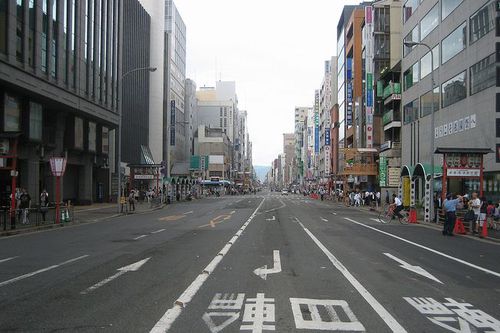August 7, 2015
Main Street of Kyoto Develops into Pedestrian-Centric Space
Keywords: Local government Transportation / Mobility

Image by Corpse Reviver Some Rights Reserved.
An improvement project has been underway on Shijo Street in Kyoto City, the city's most crowded street, since November in 2014. Under the slogan "Walking City: Kyoto", Kyoto City has been promoting the conversion of Kyoto from the existing car-centric city and society into a walking-centric one where pedestrians are given priority, with to aim of creating a non-car-centric model city. The improvement work on Shijo Street is one of the approaches for achieving the "Walking City: Kyoto" project.
Kyoto has faced various issues caused by the increase of residents depending on cars. These issues include increased numbers of tourists using cars, traffic problems, decreases in the vitality and attractiveness of the town, increases in the negative effects from global warming, and damage to the landscape. This is why Kyoto City adopted this "Walking City: Kyoto" project. To conserve and upgrade the historic town and culture that will be inherited by future generations, Kyoto has launched an approach to develop the city into a more pedestrian- and public transportation-friendly city that facilitates enjoyable walking experiences instead of driving.
Shijo Street, which is now being redeveloped, has two characteristics to be considered. The width of the sidewalk relative to the car lanes, and the number of users were unbalanced. The number of pedestrians using the existing sidewalks, with a total width of seven meters, was 7,000 per hour, while the number of car-users driving in the four-lane-street, with a total width of 15 meters, was 2,200 per hour. Another characteristic point is that Shijo Street itself functions a traffic terminal site. There is a concentration of bus routes operated by Kyoto City Bus, Kyoto Bus and Keihan Bus, and there are also many entry-exit ways into the subway and railways of Keihan Dentetsu and Hankyu Densha; thus, Shijo Street is crowded throughout the day with a large number of public transportation users.
Based on these two features, the city planned to achieve four main aims to remodel Shijo Street. The first aim was to widen the sidewalk and narrow the car lanes. The sidewalk, 3.5 meters wide on each side at present, will be widened to about 13 meters in total, while the street will be cut into two car lanes. Designed from the viewpoint of pedestrians, the plan aims to create an enjoyable and comfortable walking space at the center of the city.
The second aim is the introduction of terrace type bus stops which hang over the car way and collecting bus stops which are dispersed along the street at present to reduce the number of bus stop sites. A total of 16 bus stops, which often confuse tourists, will be aggregated into four bus stops, including east bound and west bound routes. The new bus stops are designed as terraces, where bus users and pedestrians are not intermingled, so that bus users can wait without disrupting pedestrian traffic. This design will also be beneficial for bus users in wheelchairs.
The third aim is to establish parking spaces for vehicles that need to access to the sidewalk. Vehicle users who want to visit a certain place on the street can temporarily park in one of the 15 parking spaces (32 cars possible in total). The short-term use of the spaces (5 min) is limited to vehicles stopping to drop off or pick up passengers and those loading or unloading.
The fourth aim is to set up taxi stands. There will be two taxi stands in the highest traffic areas; one in front of the Daimaru Department Store building (east bound) and the other in front of the Takashimaya Department Store building (west bound). Passengers also can get into or out of taxis in the 15 parking spaces mentioned above.
The improvement work started on November 17, 2014 and will be completed by the end of October in 2015. This is the first case in Japan of an approach to convert an existing main street in a city of more than one million people into a pedestrian- and public transportation-friendly street by reducing car lanes. It is expected that the new Shijo Street will be enjoyable and comfortable for both citizens and tourists, and that Kyoto City will recapture some of its charm.
Related
"JFS Newsletter"
- Auto Sales Industry Cooperates to Tackle Social Responsibility: Examples from Yamagata, Japan
- 'Community Car Sharing' Supports the Bond of Mutual Aid
- Resident-Led Efforts to Secure Local Public Transport Systems
- Buy Flowers Downtown and Ride the Train for Free? A Look at Toyama's Creative Approaches to Being a Vibrant City in a Time of Depopulation
Related
"Popular Articles"
- Kakegawa Declares Itself a "Slow Life City"
- Car Ownership Rate for Japanese Households Decreases
- Toyama City Works Toward Compact City Utilizing Public Transportation
- Kanagawa Pref. Announces Concept Vehicle for Electric Bus with Low, Full Flat Floor
- Kyoto Tackles Mission of Becoming World-Class Bike-Friendly City


